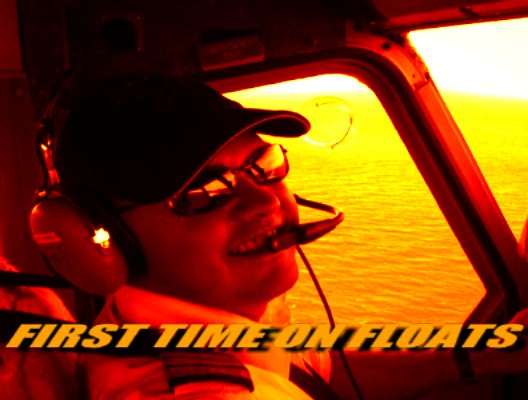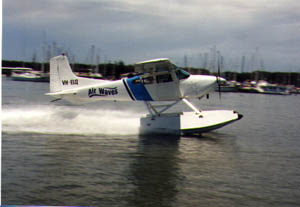
Full throttle and up on the step in VH-ELQ.
"Ok water rudders up, 20 degrees flap, keep her straight and full throttle now" Nick Beissel instructed calmly as I started my first takeoff in a floatplane. The Cessna 185 roared to life and before I knew it we had passed through the hump phase and was up on the step! Screaming across the water in a Cessna is an unusual feeling..more like driving a boat, except this little winged beauty is about to become airborne! We ran into a few small wakes from a boat that had passed in front and the aircraft piched up and down noticeably as we neared rotation. "Is that normal?" I asked "yep" was the reply as Nick's gaze was firmly outside watching a yaht approaching ahead. The aircraft became light on the floats and I applied back pressure on the yoke until she broke free and accelerated to the takeoff safety speed. WOW..what a rush! The climbout was normal and we departed for the training area for some circuits and handling on the backwaters and channels of the Nerang River.Takeoff in a floatplane is a whole new ball game because there is so much more to think about. As well as the normal factors such as wind etc..there is watercraft and boat wakes, obstacles in the water, tides and more...however once everything is checked and your roaring along up on the step it's an awsome feeling.
|
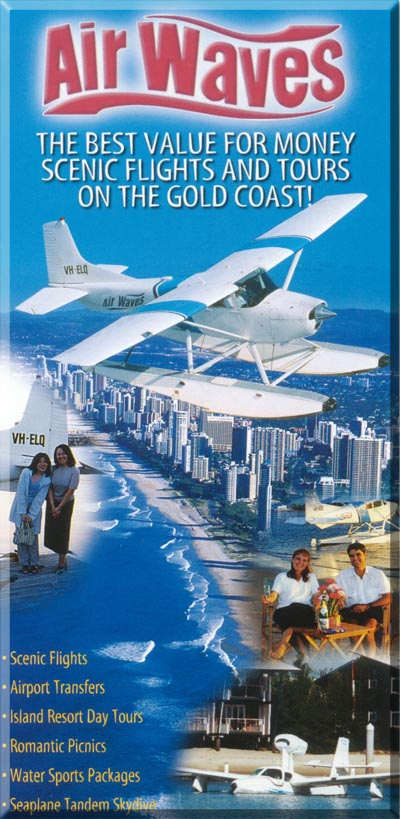
Floatplanes verses land based.
Many a time I have flown in a fixed gear aircraft over a beautiful gorge or past a white sandy beach locked away in a cove somewhere and wished I could land right there and then. Unless you are in a chopper the next best thing is a floatplane to access all those magic spots land based aircraft wouldn't dream of going. Even though land based aircraft are are endless fun, floatplanes add that "something extra" to flying that really sucks you in.
|
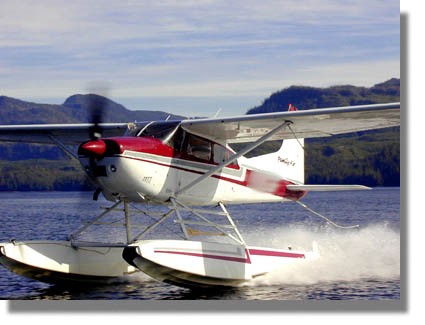
What goes up must come down!
One of my favourite parts of flying is landing and when it comes to landing a floatplane its nothing short of exhilerating. The setup for landing was much the same as any other landing except your looking ahead for all those boats, wakes, jetski's, pylons etc...and if its all clear you continue your approach. I needed to be at 60kts during the flare because the slower the aircraft is when you touch the water the better. Manual flaps are something I was used to and are a real plus for operations such as this. I noticed you need quite a high nose attitude in the flare to make sure the front of the floats are well out of the water. Flaring just above the water is an errie feeling at first and I'm sure at the back of my mind I had thoughts of a loud bang followed by a reduction in plane size. After the floats touch the water I pulled the power and woooaahh...did she slow down.. talk about your drag!! Skipping across the water at 60 knots at touchdown and then slowing to a taxi in 50 meters is something that all pilots should have a go at
|
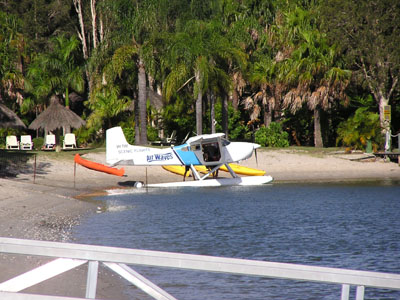
Beaching the plane can have you surrounded by spectacular scenery in no time.
Nick and I had landed in a large waterway just out from a perfect stretch of beach and that was going to be the practice ground for our beaching exercise. The first thing I had to do is have myself and the aircraft prepared before we neared the beach. Things happen much quicker when you are on the water so it's important to be thinking ahead so you don't end up in a mad frenzy at the last minute. (As I found out on my first beaching.) Nick sat there patiently as we taxied into the beach and then said "right..I want you to shut it down jump out onto the front of the float and be ready to fight off any obstacles before we touch the sand!" Well what a mad panic I was in, trying to leave the cockpit with my seatbelt still on was a non event and having the seat fully forward didn't do me any justice either! I hadn't swithched off the radios, lights/strobes or ignition and pretty much looked like I was having an epileptic fit in the cockpit as the floats ran ashore. Nick looked at me trying not to laugh and said "whadiya say we try that again hmm?" My only response was "what a complete cockup that was...lets do that again and get it right!" My second attempt was right on the money and showed that staying ahead of the aircraft and setting yourself up early can save you time and embaressment.Taxxing in at idle and pulling the mixture just out from the beach, then jumping from your seat and standing on the front of the floats to fight off any rocks that might be lurking below was just damn good fun! Oh yeah...doing it all bare foot was a buzz too. Once your floats kiss the beach it's just a matter of swinging the aircraft around pulling it up onto the beach. Then you drop the anchor in the sand or you may find the plane somewhere else completely when you return!
|
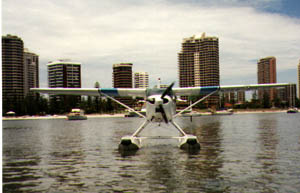
Getting close to docking which is a challenge in it's self.
Taxiing in on the broadwater to dock at the Airwaves base. Nick Beissel my instructor taught me step by step how to dock this bird. Approaching the dock at idle power then cut the engine, make some last minute rudder inputs then its out onto the floats. We drifted right into the dock and I jumped of and grabbed the wing rope to hold her in place....now that was fun! All that was left was to tie the aircraft to the dock and enjoy the smile on my face:)
|
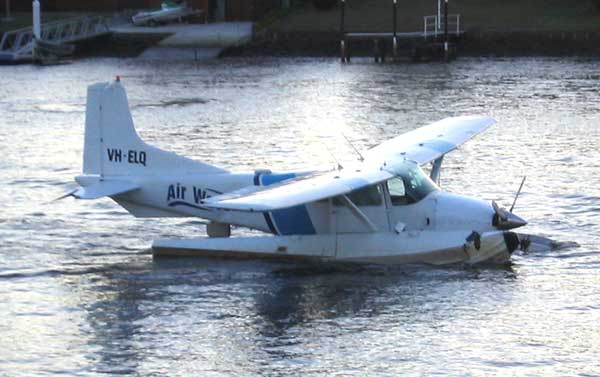
VH-ELQ (Oct 2004) came to grief in the Nerage river on the goldcoast. The pilot and pax had a lucky escape.
There is alot involved when flying floatplanes and you really have to be on the ball all the time or you could ruin your day real quick! One thing that you do notice straight away is that once your moving you can't stop in a hurry thats for sure and you have to give yourself plenty of time and room to manoeuvre. Something very simple like running up the engine for a magneto check in a confined area means you have to taxi in tight circles or you will run the risk of hitting something. Captain Joe wouldn't appreciate you turning his launch into driftwood, not to mention being out of a job when the boss found out! Tides and currents also play a big role when on the water so you have to be alert and adjust your heading so as to keep from being pushed into pylons, jettys etc. There maybe alot to know when it comes to flying floatplanes but once you have it all under control the rewards and satisfaction of acomplishing the smallest of tasks are hard to beat.
|
THANKYOU TO NICK AND THE TEAM AT AIRWAVES FOR A GREAT ENDORSEMENT.
|
